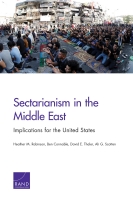by Heather M. Robinson, Ben Connable, David E. Thaler, Ali G. Scotten
 Present unrest in the Middle East has many causes and takes on many forms. A collective sense of disenfranchisement, inadequate governance, geopolitical discord, and religious extremism all contribute to the conflicts in Iraq, Iran, Syria, Yemen, and Libya. Many Western observers and policymakers view unrest in the Middle East through the lens of binary religious sectarianism, focusing on the divisions between Sunni and Shi'a Muslims. This split is most clearly articulated in the geopolitical competition between Saudi Arabia and Iran, and it plays out through violence in Iraq and Syria. But the complexities of human identity and of regional culture and history do not lend themselves to this arguably too-simplistic interpretation of the situation. The authors analyze sectarianism in the region, evaluate other factors that fan the flames of violent conflict, and suggest a different interpretation of both identity and the nature of regional unrest.
Present unrest in the Middle East has many causes and takes on many forms. A collective sense of disenfranchisement, inadequate governance, geopolitical discord, and religious extremism all contribute to the conflicts in Iraq, Iran, Syria, Yemen, and Libya. Many Western observers and policymakers view unrest in the Middle East through the lens of binary religious sectarianism, focusing on the divisions between Sunni and Shi'a Muslims. This split is most clearly articulated in the geopolitical competition between Saudi Arabia and Iran, and it plays out through violence in Iraq and Syria. But the complexities of human identity and of regional culture and history do not lend themselves to this arguably too-simplistic interpretation of the situation. The authors analyze sectarianism in the region, evaluate other factors that fan the flames of violent conflict, and suggest a different interpretation of both identity and the nature of regional unrest.
Key Findings
Sectarian conflict is more political and social than purely religious.
The drivers of conflict between the Sunnis and the Shi'a are mostly political in nature, and political and social contexts inform the primacy of sectarian identity and the prevalence of sectarianism.
Sectarianism is a two-pronged phenomenon: internal and external sectarianism.
Internal sectarianism is sectarian conflict or rhetoric on an intrastate level.
External sectarianism takes place on an interstate level and involves a sectarian actor's encouragement of sectarian divisions in foreign countries for its own political purposes.
Sectarianism may not be the most important way to understand regional conflict, which can look solely sectarian in its most simplified form.
The Sunnis and the Shi'a are not monolithic blocs — there is considerable intrasect discord and violence — so, viewing regional conflict through a strictly sectarian lens could be a major pitfall for policymakers.
Sectarianism varies between countries and regions, and it manifests itself differently in different places.
Iraq has long been considered a sectarian state, and conflict over the appropriate representation in government along sectarian lines seems to be the primary driver of conflict.
Although Iraq suffers from lasting sectarian divisions and a strong argument can be made that sectarian identity will continue to be decisive in Iraqi politics, there is nothing inherently intractable or immutable about the problem.
It would be simplistic to refer to sectarian identity as the main source of the Syrian uprising against Bashar al-Assad or as the sole motivator of continuing violence.
Recommendations
U.S. policymakers and war planners should avoid oversimplifications.
The United States should not choose between the Shi'a and the Sunnis.
Resolving local political issues may matter more than fighting sectarianism.
The United States — in particular, the Army — should eschew policies that institutionalize sectarianism in local or state institutions.
No comments:
Post a Comment